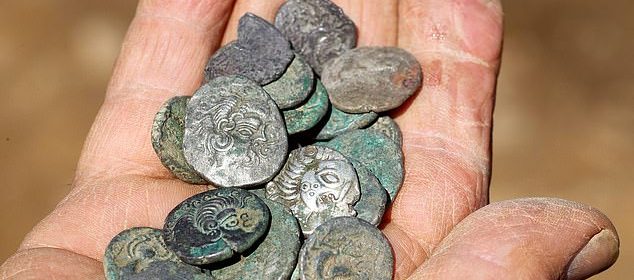$12.8 Million Celtic Coin Hoard Sets Guinness World Record

Treasure hunters find Britain’s largest coin hoard after discovering 69,347 Roman and Celtic pieces
Treasure hunters have recorded the largest coin hunt discovered in the British Isles after 69,347 unearthing Roman and Celtic coins, hidden under three feet under a hedge in Jersey, Channel Isles.

This treasured story began in the early 1980s after Reg Mead and Richard Miles read a report about a farmer on Jersey that had found silver coins in a pot many years before while pulling a tree from a hedgerow.
The pair of metal detectors then dedicated three decades to hunt for the hedgerow and its supposed treasure, and it was in 2012 they finally found a huge corroded lump of three feet of gold and silver coins under a hedge dating back to the 1st century BC.
According to a 2012 BBC report, at the time of discovery Mr. Mead said they “dug down and found a mass of coins the size of a football and when looking for the edges it went on and on and on.” Then they realized nothing like this had been discovered in Britain before, “or of this kind anywhere in the world,” he said.

It is thought that the coins had been buried in a field by members of a Curiosolitae tribe fleeing Julius Caesar ‘s army around 50 to 60 BC. But the Guinness World Record setting discovery was not easy to excavate or analyze as it was found encased in thick clay block measuring 55 x 31 x 8 inches (140 x 97 x 20 cm) and weighing three quarters of a ton.
The so-called ‘The Grouville Hoard,’ totaling 69,347 Roman and Celtic coins, is estimated to be worth around a cool £10million.

The Grouville Hoard is on display at La Hougue Bie Museum on the island of Jersey and in addition to the Roman and Celtic coins the hoard contains: silver bracelets, fine silver wire, gold torques, sheet gold and a number of glass beads.
Curator of archaeology at Jersey Heritage, Olga Finch, told The Telegraph that the Guinness award “does not surprise them” and that the institution are delighted such an impressive archaeological item was “discovered, examined and displayed in Jersey.”

The figure of £10million mentioned earlier comes from Mr. Mead, who said the “least valuable” coins in the hoard are likely to be worth £100 each, which extrapolates out to a valuation of several million pounds.
Moreover, soldered into the hulk of treasure are precious items of jewelry, which could be the same value as the coins depending on what they turn out to be.

Traditionally in England, finds like this one were often taken to local museums to record but with a lack of resources and a national reporting system, many similar finds went unrecorded. To combat this, in July 1996, the Treasure Act was passed replacing the medieval law of Treasure Trove in England and Wales, gesturing protection to archaeological finds that while not officially ‘treasure’, are important in building an accurate archaeological picture of England and Wales.
What then is ‘treasure’ according to English heritage laws? The Treasure Act 1996 has several definitions of ‘treasure’, including “prehistoric objects and coins that contain gold or silver and are at least 300 years old.”
If a find is declared ‘treasure’ then by law the finder must offer it for sale to a museum at a price established by the British Museum’s Treasure Valuation Committee , and a reward is subsequently offered to the finders, landowners and any other parties associated with the find.
What this really means is the coins officially belong to the Queen, although the finders are entitled to a reward. But sometimes treasures are just “too big,” and an article in the Daily Mail says there has been talk about the sheer number of currently rare coins adversely affecting the price by flooding the market.

As consumer metal detector technologies advance and for less than $500 dollars anyone can now buy a ‘coil’ able to penetrate almost a meter deep, there has not only been an increase in the frequency of finds over the last decade but also an increase in the sizes of finds.
It was only five months ago another huge hoard of 2,528 silver coins dating back to the aftermath of the Battle of Hastings were found by metal detectorists in the Chew Valley, northeast Somerset.
The British Museum said it was the second largest find of Norman coins ever in the UK. Lisa Grace and Adam Staples, who unearthed the bulk of the hoard, told the BBC “we’ve been dreaming of this for 15 years but it’s finally come true.
It was totally unbelievable – to find one would be an exceptional day metal detecting.”